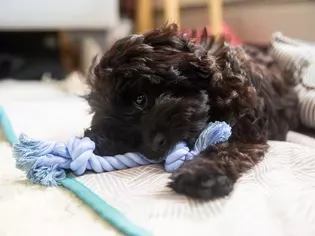How to Stop Your Puppy From Eating Everything
Updated on 05/27/24

Headline: Unleash the Zen in Your Home: A Comprehensive Guide to Curb Your Puppy's Pica
Introduction:
Welcome to the ultimate resource for dog owners facing the exasperating challenge of their beloved puppy's insatiable appetite for everything in sight. From shoes to couch cushions, no object is safe from their relentless chewing frenzy. This exhaustive guide will empower you with proven strategies to effectively address your puppy's pica, transforming your home into a harmonious sanctuary where both you and your furry companion can thrive.
Understanding Pica in Puppies:
Pica, the compulsive ingestion of non-food items, can be a frustrating and potentially dangerous behavioral issue in puppies. While it can stem from various underlying medical conditions, most cases are attributed to behavioral triggers such as boredom, anxiety, or teething discomfort. Identifying the root cause of your puppy's pica is crucial for tailoring an effective treatment plan.
Safeguarding Your Puppy's Health:
Ingesting non-food items poses significant health risks for puppies. Sharp objects can lacerate their digestive tract, while toxic substances can lead to poisoning or organ damage. Additionally, excessive chewing can wear down their teeth prematurely, causing pain and discomfort down the road. Therefore, it is essential to take immediate action to curb this behavior.
Creating a Pica-Proof Environment:
The first line of defense is to remove potential hazards from your puppy's reach. Conduct a thorough scan of your home and eliminate any objects that could tempt their chewing desires. Use baby gates to restrict access to certain areas, such as the kitchen or laundry room, where dangerous items may be stored.
Addressing Underlying Boredom or Anxiety:
If your puppy's pica seems to be triggered by boredom or anxiety, providing ample mental and physical stimulation is key. Engage them in regular play sessions, brain games, and obedience training. Interactive toys that dispense treats or provide mental challenges can keep their minds occupied and reduce their desire to chew. Additionally, consider enrolling them in puppy socialization classes to build their confidence and reduce stress.
Managing Teething Discomfort:
Teething puppies often resort to chewing as a way to relieve discomfort from their erupting teeth. Provide them with appropriate teething toys, such as rubber chew bones or frozen teething rings, to satisfy their chewing needs while protecting their gums.
Introducing Positive Reinforcement:
Rewarding your puppy for appropriate chewing behavior is a highly effective training technique. When they chew on their designated toys or designated areas, praise them enthusiastically and offer them a small treat. Over time, they will learn to associate positive outcomes with desired behaviors, reducing their likelihood of engaging in destructive chewing.
Redirection and Interruption:
When you catch your puppy chewing an inappropriate item, do not punish them. Instead, calmly interrupt their behavior, remove the object, and redirect them to an appropriate toy or activity. Consistency is crucial in this process, as it will teach your puppy to understand what is acceptable and what is not.
Medical Intervention:
In some cases, pica may be a symptom of an underlying medical condition such as gastrointestinal issues, nutritional deficiencies, or anxiety disorders. If you suspect that your puppy's pica may be medically related, consult with your veterinarian for a thorough examination and appropriate treatment options.
Patience and Persistence:
Curbing pica in puppies requires patience, persistence, and a consistent approach. It may take time and effort to fully address the underlying causes and redirect your puppy's chewing behavior. However, with dedication and the techniques outlined in this guide, you can successfully restore harmony to your home and provide your furry friend with a safe and fulfilling life.
Conclusion:
Your puppy's insatiable appetite for everything in sight doesn't have to be a source of constant frustration. By understanding the underlying causes of pica, creating a safe environment, providing ample stimulation, and implementing positive reinforcement, you can effectively address this behavioral challenge. Remember, consistency and patience are key to transforming your home into a sanctuary where both you and your beloved canine companion can thrive.
Explore More Pets

Basic Training
Puppy and Baby Introductions

Working Dog Breeds
All About Search and Rescue Dogs

Dog Treatments
Puppy Vaginitis: Signs, Causes and Treatment

Dog Adoption
After More Than 1,200 Days in the Shelter, Coco Goes Home

Basic Training
How to Train Your Puppy to Go on Potty Pads

Hybrid Dog Breeds
The Difference Between a Mutt, Mixed Breed, or Designer Dog?

Dog Treatments
Nail Problems in Dogs

Puppies
7 Reasons Why Two Dogs Are Better Than One
